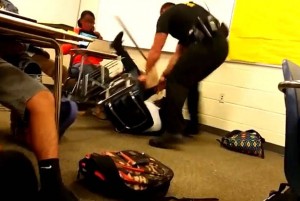Last week, on almost every social media and news outlet, a clip was being played that showed Ben Fields, a high school resource officer placing his hands near a student’s neck, and pulling her to the ground after she refused to give up her phone. The clip then goes on to show the officer harshly dragging the student towards the door while also voicing threats to other students who reacted by shouting back at the officer. The officer’s hasty and overly-involved actions have called into question how much authority school officers should have when dealing with disruptive students and what student actions deserve discipline?
A main task of a high school resource officer, according to their general job description, is to provide law enforcement and police services by “initiating interactions with students in school.” But when does interaction go too far?
At Leesville, we have a great resource officer who knows how to correctly handle students and do his job. Most schools have officers like this, but it is the few bad ones that tarnish the job reputation.
Officer Greene has been working at Leesville for five years but he is no stranger to law enforcement. Greene has been working as a police officer for 18 years, starting March of 1997.
As a resource officer, Greene has strict rules to follow. “I enforce all criminal laws, not school policies or violations. Of course, I can still assist staff with school violations if necessary,” said Greene.
Throughout his time at Leesville, Greene has only had to use physical force on two students. “There was a large fight in the bus lot several years ago, and I had to use pepper spray. Also there was a student last year in the main lobby area. I was trying to break up the fight, and she began to resist, so I had to use pepper spray again. Those are the only two incidents where I had to use any physical force,” said Greene.
Greene went on to explain that resource officers are instructed to use the least amount of force possible for the situation at hand. By using pepper spray, Greene avoided having to use too much hand-to-hand contact with the students.
It is these alternatives to physical contact, such as pepper spray, that make the South Carolina incident so controversial. “I don’t believe that was the least amount of force he could have used. I agree how he started. From the video, it appears he initially grabbed her arm to maybe try to escort her out of her seat. Now if she had begun fighting, swinging or kicking, that may have made his actions more justifiable. But in the video it appears she does nothing but sit there like a silent protest,” said Greene.
I watched the video several times to see if I could understand what provoked the officer to take such rash action but I could find nothing. It is very understandable to use physical force like that if the student is endangering the officer or any other individual, but no one was being endangered by her actions.
This incident is not the first time physical contact has been taken too far in the last month. On October 8, a school resource officer in Texas grabbed a student by the neck and slammed him to the ground after allegedly attempting to break up a fight between two students.
According to the Huffington Post, 25 cases of students and faculty across more than a dozen states had to seek medical attention due to resource officers using control methods such as tasers, pepper spray and stun guns. Other cases, compiled by Mother Jones, shows more physical encounters including chokeholds, beatings with batons, and in one case, death.
These cases are not to bash all school resource officers because they do play a large part in the safety of schools. It is just to say there needs to be reassessments on the level of acceptable interactions between students and officers and reassessments on the types of student actions that should grant discipline. At the moment, the line is not clearly drawn, and this results in unnecessary injuries and poor reputations cast on both parties.

Leave a Reply